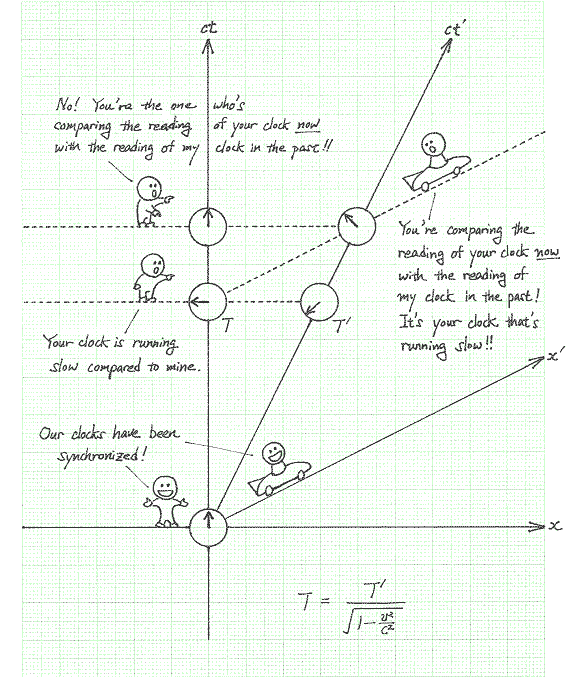

|
College of Science Physics Dept Tatsu Takeuchi Special Relativity Lecture Notes |
 1
2
3
4
5
6
7
8
9
10
11
12
13
14
15
16
17
1
2
3
4
5
6
7
8
9
10
11
12
13
14
15
16
17

12. Time DilationAnother consequence is that clocks in different inertial frames will be observed to run at different rates. First, let's consider carefully how we compare the running of two clocks. I think everyone would agree that the correct procedure is:
Now, assume that two observers in different inertial frames synchronized their clocks at the origin of the spacetime diagram below. Both clocks are at the same place at the same time in both frames so if the clocks give the same reading here step 1 above is OK. Step 2 is the problem. (Note: since both observers are in inertial frames, the clocks will keep on moving away from each other and you can no longer place them side by side to see if they give the same reading or not.) When the stationary observer wants to compare the reading of his stationary clock with the reading of the moving clock, he will compare the reading of the two clocks "at the same time" in the stationary frame, which is NOT "at the same time" in the moving frame. Similarly, when the moving observer wants to compare the reading of his moving clock with the reading of the stationary clock, he will compare the reading of the two clocks "at the same time" in the moving frame, which is NOT "at the same time" in the stationary frame. In fact, if you study the spacetime diagram below, you can convince yourself that both observers will think that the other observer is comparing the reading of the other clock with the reading of your clock in the past! 
As a consequence of this disagreement on when "at the same time" is, clocks that are moving relative to your frame will always be observed to be running slower than your stationary clock. If the reading of the stationary clock is T, and the reading of the moving clock "at the same time" in your frame is T', then T and T' are related by 
where v is the relative speed of the moving clock. This effect is known as time dilation.
|